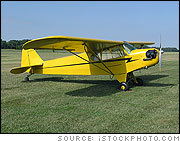Private Planes: Piper Cub

"Flies like a Cub" is still the pilot's ultimate compliment for an airplane
by David Noland
 Piper Cub Specs
Related Links |
To the American public, "Piper Cub" is the generic name for any small single-engine private plane. Like Kleenex or Scotch tape, the Cub was a basic no-frills product that dominated its marketplace and achieved universal name recognition. And like them, it's still in wide use many decades later.
Top Seller
The Piper J-3 Cub was first introduced to the flying public in 1938. A high-wing two-seater, it could putt-putt along at 60 mph with its 40-hp engine. Like many small planes of the day, it had a framework of steel tubing covered with cotton fabric. In the fashion of Henry Ford's Model T, it was available in only one color: bright yellow, with a black lightning stripe down the side. At a sticker price of just $1,325, the Cub quickly become the top seller in the emerging private plane market.
Military Training Plane
As war clouds gathered in 1940, the Cub (by now souped up to 65 hp) became the primary training plane in the Civilian Pilot Training program. In that role, it introduced tens of thousands of young men—including an ambitious young fellow named John Glenn—to the joys and challenges of flying. A military version, the L-4 Grasshopper, flew observation and liaison missions throughout WW II.
In 1946, Piper built more than 6,000 Cubs to satisfy pent-up demand after the war, much of it from returning military pilots ready to embrace the post-war American dream. That's still the record for the most civilian aircraft of one type manufactured in a single year. Cubs were rolling off the Piper production line in Lock Haven, Pa., every 20 minutes.
But the post-war boom died quickly, and in 1947 production of the J-3 model ended. A total of 14,125 had been built, more than any private plane model ever. An improved version, the PA-18 Super Cub bush plane, remains in production to this day.
Still Flying
Some 5,000 J-3 Cubs are still flying, many of them impeccably restored and commanding prices of up to $40,000. Pilots prize them for their antique appeal and simple, forgiving handling qualities. "Flies like a Cub" is still the pilot's ultimate compliment for an airplane.
Flying a Cub has always been about fun, pure and simple. Dodging around puffy clouds. Skimming the treetops with the window and flop-down side door open. Landing on a beach or grassy field just to see what's there. You still start the engine of a Cub by giving the propeller a flip, just like in the old days. You navigate with your eyeballs, and a map on your lap. There's no radio to distract you. When you fly a Piper Cub, it's just you and the air.








